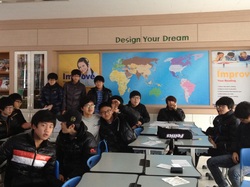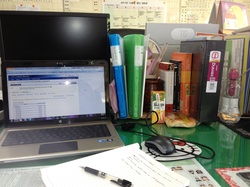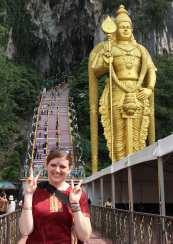I'll be offline for awhile as I enjoy a trip abroad for a couple of weeks. I am unsure if I'll have access to the internet during my adventures so unfortunately there won't be any updates. However, once I return I'll be sure to post lots and lots of pictures because this trip is by far going to be one of my most memorable. I'll share all the exciting details when I return!
0 Comments
 Though Korea acknowledges the new year on January 1st the real celebration doesn't occur until weeks later on Seollal, the lunar new year. This year Seollal is mid-January and will be celebrated throughout Korea, China, Vietnam and many other countries. Unfortunately I won't be in Korea to observe the celebration but it's been interesting to observe people preparing for the holiday.
Many Koreans return to their hometowns to celebrate Seollal. It's a holiday centered around family - both the living and the departed. My Elementary students told me that they wear traditional clothing, like pictured above, and visit their grandparents for the new year, bowing deeply onto the floor and asking them for good wishes. In response the grandparents might impart upon the child a piece of wisdom and typically will hand him or her an envelope with money. Altars to departed ancestors are also set up in the homes with a variety of fresh fruit and other food presented on special dishes. Gifts seem to be a big part of the Seollal celebration and the local market set up numerous displays of boxed sets for the holiday. These sets consist of products such as beautifully arranged rice cakes, bottles of alcohol, fresh fruit and spam. Yes, spam. The store has been bustling with people buying the boxed sets and in the past few weeks women wearing hanbok line the main aisle greeting shoppers as they walk by. Hopefully next year I'll be in Korea to celebrate the holiday. Below I posted a few pictures from the store to illustrate some of the items which are for sale for Seollal.  The idea of teaching English to a group of high school boys who would rather spend their break probably just about anywhere but at school is somewhat daunting. Though technically most schools are on break all throughout January and February there are still winter camps being held at many schools. Winter camps are basically classes conducted throughout the break for students who sign up for them. I am unsure how they are organized at other schools but at Mungyeong Technical High School each winter camp consists of four 50 minute daily sessions over the course of 5 days. English winter camp was scheduled for this week and my co-teacher divided the 4 daily classes between the two of us. I taught from 9am-11am each day and he taught the remaining two hours.
It was difficult to plan for my classes because I did not know how many students would attend and what level at which their English would be. Camps here are voluntary and I'm unsure why a student might sign up for any one particular camp, especially English camp in which few students are truly interested. Since I knew the students didn't really want to study English during their break I decided to try to make the classes as engaging as possible with reasonable expectations of how much English the students would actually use. After reading over posts from other native English teachers on an online discussion board I decided that I would focus the camp around one topic and create activities based around it. After some deliberation I picked zombies because with recent movies like Zombieland as well as Tv shows such as The Walking Dead I knew there'd be a plethora of videos the students could watch. So, I spent the first few weeks creating a variety of activities based around the concept of a zombie apocalypse. Winter camp began on Monday and I was surprised to discover that the 14 students who showed up were all first year students. Over the course of the next few days two 2nd year students attended the camp sporadically but the first year students showed up regularly though a few were frequently late. The boys enjoyed the zombie theme and though they weren't overly keen on writing out their own zombie rules they were at least somewhat involved in class because participation points earned them candy. By the end of the week we had completed our lessons and since they were reasonably well behaved I let them watch a movie in the final 3 classes. Now that winter camp is over the boys can go back to playing video games, watching TV and sleeping and I can look forward to my upcoming vacation. Overall I would say it was a good experience and gave me the opportunity to get to know a few new students who will be in my English classes in the new school year which begins in March. My friend Melanie has a tradition on her blog where she posts a single photo every Friday with no words which illustrates a moment from the previous week. I felt inspired by the concept and decided to adopt it for my own blog. Each week I will post a single photo with no words from a moment in my life, a simple yet memorable image to share with everyone.
 Earlier this month I finalized my winter vacation plans and began preparing for the upcoming trip. When I traveled to countries like Spain, the Netherlands or Japan it meant I just needed to know what the weather might be like and cultural norms so I could pack the appropriate clothes. However, when preparing to travel to South East Asia preparing for a trip typically involves a visit to the doctor for a slew of vaccinations. I visited the Center for Disease Control's website and read up on what vaccinations and medication are recommended for an American traveling abroad in that region of the world. Thankfully I already have been vaccinated against Hepatitis A and B as well as tetanus a few years back before I went to Vietnam. For this trip I determined I would need a typhoid shot in a addition to malaria pills. A waygook friend told me that she had met an English speaking doctor at the central hospital and I was elated. If you've ever traveled abroad you know that the language barrier can be frustrating - now imagine if you could not properly communicate with your doctor. It's quite frankly a bit frightening and therefore I was relived to hear this wouldn't be a problem.
In the United States when you visit a doctor the procedure is pretty set - you make an appointment, show up at the required time, briefly go over your medical history and then you are advised by your doctor what steps you should take. I assumed that the experience would be similar here in Korea and so I was presented with the problem of how I would proceed since I don't speak enough Korean to schedule a doctor's appointment. I realized I would have to depend on another person to help. For me one of the most frustrating aspects of living abroad is feeling powerless and having to depend on another person to help you successfully achieve even the most simple acts. In this situation I had to depend entirely on another person to help me with the doctor's appointment and it became a somewhat stressful situation for me because it was necessary that I get the vaccination and start taking the malaria medication at the very latest one week before the trip. As the days turned into weeks and the appointment still had not been made I became overly anxious that I would not be vaccinated in time. So I decided to be proactive and reached out to a friend who speaks some Korean. She called the hospital for me and to my surprise no appointment was necessary. She then sent me a note over instant messenger in Korean explaining why I needed to see a doctor for me to take along. I excused myself from work a few minutes early and made my way to the hospital and with that note prominently displayed on my phone in addition to the doctor's name I managed to get in and see the doctor. I spent less than 15 minutes in the hospital and left with a script for malaria medication and directions to the local health center where vaccinations are administrated. There I simply walked in the door, showed the technician the name of the vaccine in Korean and received a quick shot. I even got a doraemon band aid :) Now that I've gone through the process once I feel better knowing that the next time will be much easier and planning a visit to the doctor is not something about which I should worry. My friend Melanie has a tradition on her blog where she posts a single photo every Friday with no words which illustrates a moment from the previous week. I felt inspired by the concept and decided to adopt it for my own blog. Each week I will post a single photo with no words from a moment in my life, a simple yet memorable image to share with everyone.
 There's a lot we all take for granted especially when it comes to somewhat mundane activities such as a visit to the hair salon. Getting a hair cut back home is a relatively simple activity - you go in, describe what you want, maybe show a picture or two and more often than not you leave with what you requested. Getting a haircut in a country you don't speak the language can be a slightly frightening experience - thankfully, I'm a bit apathetic towards my hair. When I was in college I had an unfortunate experience with a hairdresser who managed to cut off my shoulder length hair into a boy cut because she was distracted by her conversation with other people in the shop. I took to heart the lesson from that experience that hair does indeed grow back - even if it takes nearly a year.
Overall appearance including one's hair here in Korea is a big deal - young people, male and female, spend a great deal of time fixing their hair. Most of my male students have perfectly coiffed hair with their bangs swooping to one side like their favorite KPop star. Many of the female students have sleek straight hair usually with blunt bangs. Few young females have hair shorter than shoulder length and it's unusual to see a man with long hair. The public school system here typically has rules regarding hair - students are not supposed to dye it nor perm it though it's apparent these rules are not always adhered. Reddish brown is a popular hair color here - both with males and females, in school and out of it while I've seen a few men sporting a hair wave which gives some body to the typical straight Korean hair. Going to the hair salon here turned into a relatively easy experience. The salon was recommended by a fellow foreign teacher who even accompanied me on the trip because she wanted to get her own hair cut and colored. She speaks a bit of Korean and was able to get across I just wanted my hair trimmed. Overall the experience was very similar to getting your hair cut in the United States - the stylist washes your hair, gives you a quick cut and then dries and styles it for you. It was straightforward, quick and best of all - incredibly affordable. The entire cut cost me 10,000 won (~$9). My friend with her cut and color spent just 35,000 won. The final test for my hair - the next day when I wash and dry it does it still good with minimal effort - and I was happy to see that it did. It's a relief that another pedestrian activity which sometimes can be much more difficult abroad is still relatively easy. My friend Melanie has a tradition on her blog where she posts a single photo every Friday with no words which illustrates a moment from the previous week. I felt inspired by the concept and decided to adopt it for my own blog. Each week I will post a single photo with no words from a moment in my life, a simple yet memorable image to share with everyone.
 With the onset of winter break and therefore no classes I spend my weekdays doing something that affectionately gets referred to as "desk-warming." This isn't a Korean concept (at least not of which I know) but something that seems to be part of teaching English abroad in public schools. I desk-warmed during breaks my first year in Japan until my school realized that having me come in daily to sit at my desk and read, watch movies or wander around the school and overfeed the koi was pointless and they told me to stay home. Here in Korea I've just begun my desk-warming duties and get to look forward to hours upon hours at my desk until early March with the occasional class for winter camp, upcoming vacation or when school restarts at Yeongsun Elementary School. I can't complain about the concept of desk-warming, I am paid well to come into school each day and have the sole discretion how to spend my day. On a typical day I read the news, surf the internet, study a little Korean, write a couple of pages for my thesis and plan my winter camp classes. However with the lack of insulation in buildings here I spend most of the day quite cold - in addition to my normal winter layers I wear a fleece jacket and drape a blanket across my lap.
The office is typically quiet throughout the day, on average only 4 teachers are in the office of approximately 30 people throughout the day and there have been periods when I realize I am the only one there. One of the perks of desk-warming is that I there seems to be a daily snack. I am unsure where these treats come from but every day morning of the office works brings around a pastry and a type of fruit drink and offers them to the few teachers in the office. This helps break up the day which seems incredibly long when I remain seated at my desk all day. |
| Mindy in the City |
|








 RSS Feed
RSS Feed